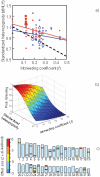Selection for heterozygosity gives hope to a wild population of inbred wolves
- PMID: 17183704
- PMCID: PMC1762340
- DOI: 10.1371/journal.pone.0000072
Selection for heterozygosity gives hope to a wild population of inbred wolves
Abstract
Recent analyses have questioned the usefulness of heterozygosity estimates as measures of the inbreeding coefficient (f), a finding that may have dramatic consequences for the management of endangered populations. We confirm that f and heterozygosity is poorly correlated in a wild and highly inbred wolf population. Yet, our data show that for each level of f, it was the most heterozygous wolves that established themselves as breeders, a selection process that seems to have decelerated the loss of heterozygosity in the population despite a steady increase of f. The markers contributing to the positive relationship between heterozygosity and breeding success were found to be located on different chromosomes, but there was a substantial amount of linkage disequilibrium in the population, indicating that the markers are reflecting heterozygosity over relatively wide genomic regions. Following our results we recommend that management programs of endangered populations include estimates of both f and heterozygosity, as they may contribute with complementary information about population viability.
Conflict of interest statement
Figures




References
-
- Hedrick PW. Conservation genetics: where are we now? Trends Ecol Evol. 2001;16:629–636.
-
- Gilpin ME, Soulé ME. In: Conservation Biology: the science of scarcity and diversity, Soulé ME, editor. (Sinauer Associates); 1986. pp. 19–34.
-
- Garner A, Rachlow JL, Hicks JF. Patterns of genetic diversity and its loss in mammalian populations. Conservation Biology. 2005;19:1215–1221.
-
- Keller LF, Waller DM. Inbreeding effects in wild populations. Trends Ecol Evol. 2002;17:230–241.
-
- Pemberton J. Measuring inbreeding depression in the wild: the old ways are the best. Trends Ecol Evol. 2004;19:613–615. - PubMed
Publication types
MeSH terms
LinkOut - more resources
Full Text Sources

